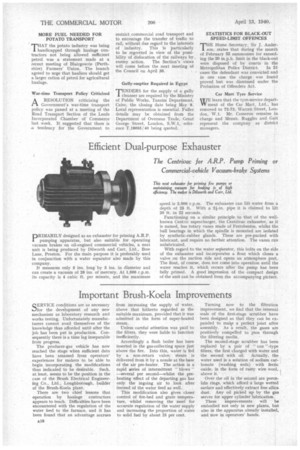Important Brush-Koela Improvements
Page 20

If you've noticed an error in this article please click here to report it so we can fix it.
SERVICE conditions are as necessary for the development of any new mechanism as laboratory research and works testing. Unfortunately manufacturers cannot avail themselves of the knowledge thus afforded until after the job has been put in production. Consequently there is a time lag inseparable from progress.
The producer-gas vehicle has now reached the stage when sufficient data have been amassed from operators' experiences for makers to be able to begin incorporating the modifications thus indicated to be desirable. Such. at least, seems to be the position in the case of the Brush Electrical Engineering .Co., Ltd., Loughborough, builder of the Brush-Koela plant.
There are two chief lessons that operation by haulage contractors appears to teach. Difficulties have been encountered with the regulation of the water feed to the furnace, and it has been found that an advantage accrues from increasing the supply of water, above that hitherto regarded as the suitable maximum, provided that it was admitted in the form of super-heated steam.
Unless careful attention was paid to the filters, they were liable to function inefficiently.
Accordingly a flash boiler has been inserted in the gas-collecting space just above the fire. Into this, water is fed by a non-return valve; steam is delivered from it by a nozzle at the base of the air pre-heater. The action is a rapid series of intermittent " blows" —several per second—whilst the preheating effect of the departing gas has only the ingoing air to look after instead of the water feed as well.
This modification also gives closer control of fire-bed and grate temperature, whilst removing the need for accurate regulation of the water supply and increasing the proportion of water to solid fuel by about 25 per cent. Turning now to the filtration improvement, we find that the internal seals of the first-stage scrubber have been designed so that they can be expanded to male a perfect joint after assembly. As a result, the gases are positively compelled to pass through the filtering media. • The second-stage scrubber has been replaced by a pair of " can "-type filters, the first charged with water and the second with oil. Actually, the water used is a solution of sodium car• bonate (washing soda) with ferric oxide, in the form of rusty wire wool, above it.
Over the oil in the second are porcelain rings, which afford a large wetted surface and effectively extract fine silica dust. Any oil picked up by the gas serves for upper cylinder lubrication.
These improvements will be embodied not only in new plants, but also in the apparatus already installed, and now in operators' hands,




















































